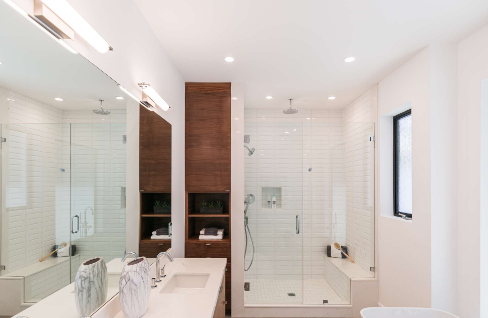Bathroom lighting plays a crucial role in setting the overall tone and aesthetic of one of the most used rooms in the home. Not only does it provide essential illumination for routine tasks like getting ready, showering and grooming, but it also enhances the overall ambiance and feel of the space. Whether it's a stylish vanity mirror light, decorative ceiling fixture or recessed downlights, the right bathroom lighting design can dramatically transform the look and functionality of the bathroom.
In this article, we will delve deeper into various aspects of bathroom lighting. We will first discuss the different types of bathroom lights available such as vanity lights, ceiling fixtures, under cabinet lights and more. Next, we will cover lighting techniques and design tips to properly illuminate different zones in the bathroom. We will then explore factors to consider like wattage, color temperature, durability and more when selecting bathroom lights. The article will also provide bathroom lighting ideas and photos for different styles. By the end, readers will gain a comprehensive understanding of choosing, installing and designing the perfect bathroom lighting scheme.

Types of Bathroom Lights
Vanity Lights
Vanity lights are one of the most common and essential types of lights used in bathrooms. They are usually mounted above or on either side of the bathroom vanity to provide focused illumination for grooming tasks like applying makeup, shaving, brushing teeth and more. Vanity lights come in various styles like linear bars, pendants, flush mounts and more. They can be recessed, surface-mounted or have an extended arm. LED vanity lights are a popular choice these days due to their energy efficiency and long life.
Ceiling Fixtures
Ceiling fixtures are ideal for bathrooms to create ambiance and spread diffused light. They come in various designs like flush mounts, semi-flush mounts, chandeliers and modern formed glass fixtures. Recessed ceiling lights are another convenient option that do not protrude below the ceiling line. Bathrooms with high ceilings lend themselves well to decorative pendant fixtures suspended from the ceiling.
Under Cabinet Lights
Under cabinet lights are a practical addition for bathrooms with vanities. Installed under wall-mounted vanity cabinets, they direct light exactly where it is needed on counter spaces without shadows. They help illuminate the entire vanity mirror and counter area. Under cabinet lights often come in the form of LED light strips.
Downlights
Recessed downlights or potlights are perfect for bathrooms as they do not take up space like other fixtures. Installed flush with the ceiling, they can be directional to focus light where required or wide-angle to spread ambient light. Downlights come as trims installed around a recessed can or as portable fixtures. Hardwired or battery-operated models are available.
Heat Lamps
Bathroom heat lamps provide essential warmth as well as light. Integrated with ventilation fans, 2-in-1 and 3-in-1 bathroom heat lamps offer twin benefits of illumination and heat. They are ideal for keeping bathrooms warm and comfortable.
Mirror Lights
Mirror lights are vanity lights designed specifically for illuminating spaces in front of bathroom mirrors. Often featuring adjustable arms and 360-degree heads, they precisely direct light on the face and mirror area for grooming and makeup application. Some models have built-in LED magnifying mirrors as well.
Accent Lights
Decorative accent lights add design elements that uplift the bathroom's aesthetic appeal. They include sconces mounted on walls, underlit shelves, illuminated mirrors, and LED strip lights concealed behind vanity cabinets or in drawers. Finishing touches like bath strips add ambient atmosphere.
Designing Zones with Layered Lighting
For bathrooms, it is essential to establish different zones with the help of layered lighting. This involves using various types of bathroom lights together to distribute task, accent and ambient light optimally across the space.
A few common lighting zones seen in bathrooms include:
-
Vanity zone – Focused lighting like vanity fixtures, under cabinet strips and downlights provide intense illumination for grooming tasks.
-
Shower/tub zone – Showerhead with integrated nightlight or recessed trims above tub keeps this wet area safely lit.
-
Entry zone – Sconces by the door or picture frame lights create a welcoming glow.
-
Toilet zone – Motion sensor lights or wall Washers light this private corner discreetly.
-
Ambient zone – Flush mount or semi-flush ceiling fixtures spread a diffused glow overall.
By combining direct and indirect lights that play different roles, the whole bathroom can be evenly brightened to suit all activities throughout the day and night. Proper zoning also enhances the functionality, style and practical use of space in a bathroom.
Factors to Consider for Bathroom Lighting
When choosing fixtures for bathroom lighting projects, it is important to take the following key factors into account:
Wattage – Bathroom lights need adequate wattage ranging usually from 50-100W for task lights to spread sufficient light. Opt for higher wattage if the bathroom is large.
Color Temperature – Warm white or soft white (2700-3000K) lamps generate a cozy ambiance in bathrooms. Cool daylight (5000-6500K) is preferable for applications needing focus like vanity mirrors.
Durability – Bathrooms experience more humidity than other rooms. Look for lights rated IPX4/IPX5 water-resistant standards to prevent water damage from splashes and moisture.
Mounting – Consider how fixtures will be mounted – recessed, surface mounted or as pendants. Ease of installation is important since bathrooms have tiles and less wall space.
Style – Choose lamp/fixture designs that match the bathroom decor from modern to traditional styles. Materials like metal, glass and wood offer various aesthetics.
Energy Efficiency – LED lights are increasingly common choices thanks to their longevity and lower energy usage compared to halogen or incandescent bulbs.
Budget – Set a price range and evaluate fixtures accordingly. High-end designs use superior materials but basic practical models work too.
Placement – Maps out where lights will be installed factoring the bathroom layout to fully cover all zones evenly.
With these crucial factors evaluated during selection and installation, the bathroom lighting design is sure to serve its purpose beautifully for many years.
